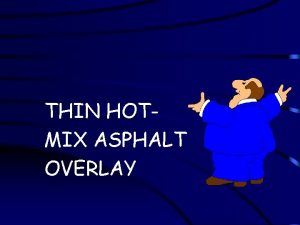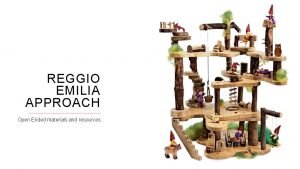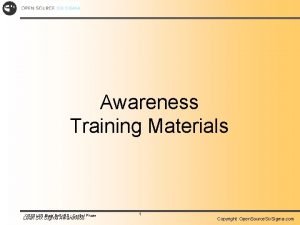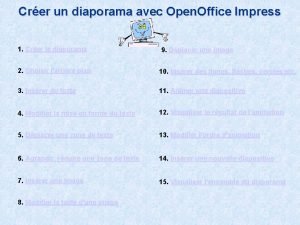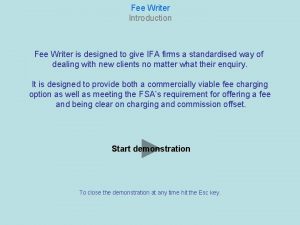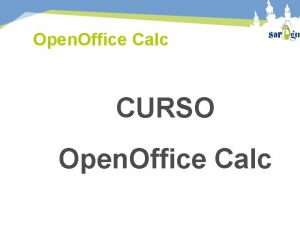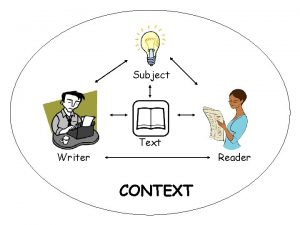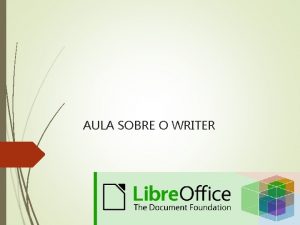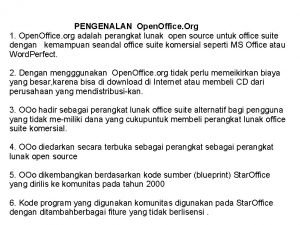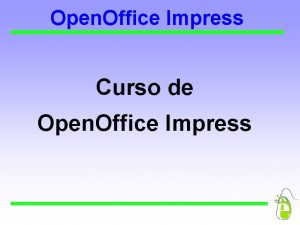Open Office Writer Introduction AOSS Course material AOSS
















- Slides: 16

Open Office Writer Introduction AOSS _ Course material AOSS Master training workshop Singapore 2007

Writer Outline Introduction Creating Open. Office Document Writing, Editing, and Reviewing Documents Using Templates and Styles Effectively Create Table Spell check Thesaurus Autocorrect / Auto format Inserting Pictures & Graphics Tables of Contents, Indexes, Hyperlinks Converting to Microsoft Word

Getting Around OO. o main toolbar object toolbar function toolbar Toolbars - main toolbar, object toolbar, function toolbar

Create Document Creating Open. Office Document Main Menu --> Office --> Open. Office. org Writer From Open. Office. org, click File --> New --> Text Document Enter text as you would for a text editor

Create Document File functions/operations, from menu bar at the top select: File --> New --> Text Document - creates a new empty, untitled document for you to work on. File --> Open - opens an existing document. File --> Close - closes the document you are working on. If changes have been made since your last save, you will be prompted to save or discard those changes. File --> Save - saves the document you are currently working on. File --> Save As. . . - saves an updated version of a document in a different location, with a different name, from the previously saved version.

Writing, Editing, and Reviewing Documents To copy text: select the text with the mouse, then select Edit -> Copy. Now the selected text is kept in memory for use elsewhere. To paste text: find the spot where text needs to be placed, place the cursor there, and then select Edit --> Paste. To cut text: this means that the selected text will be removed from the current location and kept in memory, to be placed elsewhere. Doing this is exactly like how a copy should be performed, except select Edit --> Cut instead. To undo an action: Select Edit --> Undo. It will display the command that it is undoing at the moment.

Templates and Styles Effectively Using Templates and Styles Effectively From the main menu, choose File > New > Templates and Documents. In the box on the left, click the Templates icon if it is not already selected. A list of template folders appears in the center box. Double-click the folder that contains the template that you want to use. A list of all the templates contained in that folder appears in the center box. Click the template that you want to use. You can preview the selected template or view the template’s properties: To preview the template, click the Preview icon. (A preview of the template appears in the box on the right). To view the template’s properties, click the Document Properties icon (beside the preview icon). The template’s properties appear in the box on the right.

Templates and Styles Effectively (cont. ) Using Templates and Styles Effectively (cont. ) Type My Cats. Click Format > Styles and Formatting. The "Styles and formatting" window appears. Click Paragraphs Styles. The "Paragraph Styles" menu appears. Right-click and choose the heading that you want. A small menu appears. Click Modify. The "Paragraph Style: Heading X" window appears. Click the Alignment tab. In the “Options” section, click Center. (A dot appears before the word “Center”. ) Click the Font tab. If it is not already selected/highlighted, click Arial ("Font) > Bold ( “Typeface”) > 20 pt. (“Size”) > OK. . Double-click Heading X. The words, "My Cats", move to the center.

Create Table Click Table > Insert > Table. (The “Insert Table” window appears. ) In the Name box, you will see Table 1. (This means that this is the first table you inserted in this document. If you insert another table in this document, the name will be “Table 2”. ) Under Size, Columns, click on the to change the number to 5. Under Rows, click on the to change the number to 5 Under Options > Borders > OK. (A table appears that has 5 rows and 5 columns. There is a check mark by Borders by default. To have a table without the borders being seen or printed, remove the check mark by Borders. )

Create Table: Inserting Row(s) To additional rows, click after the last word in the last column on the right. Press the tab key. (A row appears after the last row. ) To add rows between rows, click in the row in the Table where you wish to add a row before or after. Click Table > Insert > Rows. Under Insert, Amount, click on the Amount and select the number, 4, for the number of rows. Under Position, click Before. “After” is the default selection. (4 new rows are added in the Table. )

Create Table: Inserting Column(s) Click in the second column, click Table > Insert > Columns. Under Insert, Amount, click on the and click 1. Select the position of column(s) Before > OK. “After” is the default selection. (A column appears between the original first and second columns. )

Spellcheck Open. Office writer and the document you wish to edit. Click Tools Click Spellcheck

Thesaurus Select the word or phrase you want to find alternatives for and select Tools > Language > Thesaurus or press Control+F 7. Click on a meaning to show alternative words and phrases for that meaning of the word.

Autocorrect/Autoformat By going to TOOLS then AUTOCORRECT, you can see the list of existing words Writer is programmed to correct. Within this window, you have the option of setting exceptions for words to be corrected, and you can add other words that you may commonly misspell to be corrected automatically.

Inserting Pictures & Graphics Go to INSERT in the menu bar, and the bottom set of features lists pictures and graphics Choose to insert a picture from an existing file or a scanned item. If choose to insert a picture from a file, you will be prompted to locate the file and picture on your computer.

Converting to Microsoft Word When the document is completed, save it as a regular Open. Office document. (This is to keep a completed copy “just in case. ”) Convert the file: in the File menu, select Save As. At the bottom of the window, use the dropdown menu (Save as type: ) to change the file format. Choose: Microsoft Word 97/2000/XP (. doc)
 영국 beis
영국 beis Sailor course brick
Sailor course brick Course number and title
Course number and title Chaine parallèle muscle
Chaine parallèle muscle Gd and t symbols
Gd and t symbols Standard costing and variance analysis formulas
Standard costing and variance analysis formulas Material and non material culture examples
Material and non material culture examples Examples of non material culture
Examples of non material culture Example of material culture
Example of material culture Useful and harmful materials example
Useful and harmful materials example Ultra thin bonded wearing course
Ultra thin bonded wearing course Ocw metu
Ocw metu Internetmultimedia org live stream
Internetmultimedia org live stream Reggio emilia toys
Reggio emilia toys Open source six sigma training material
Open source six sigma training material Office and factory
Office and factory Diaporama avec open office
Diaporama avec open office










